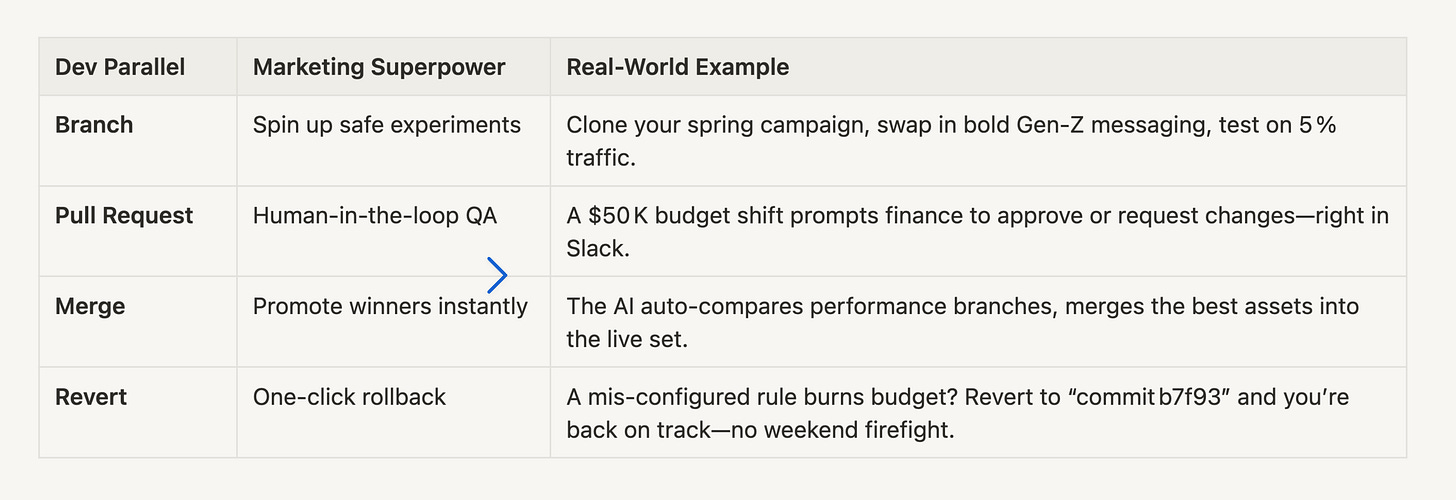Git for Marketing: How Agentic Versioning Turns Every Campaign into a Living Codebase
Agentic design is the upgrade: software conceived as a fluid ecosystem of intelligent agents that form pop‑up teams, create work, and adjust spend in real time
Developers have long enjoyed a super‑power called Git—a time machine that tracks every change, lets teams branch new ideas, and roll back anything that breaks production. Marketers, meanwhile, have been stuck in screenshot purgatory: Q4_Concept_v4_FINAL‑FINAL.pptx and Slack threads titled which‑budget‑is‑right?
That ends with agentic design. By treating campaigns, creatives, and media plans as version‑controlled artifacts—auto‑committed whenever an AI agent tweaks a headline or reallocates spend—we unlock a radically new way to create, experiment, and govern. Below is my blueprint for this “Git for Marketing” world.
1. Every Change Is a Commit
In an agentic system, specialized agents—Creative Generator, Bid Optimizer, Audience Builder—assemble on demand. The moment any agent:
rewrites copy,
generates a new ad variant,
or shifts $10 K from display to CTV,
it commits a new version: timestamp, diff, author (human or agent), and reason code. Nothing is lost, everything is traceable.
2. Branch, Test, Merge—Without the Chaos
3. Pop‑Up Studios, Not Dashboards
Ask a plain‑language question—“Give me three TikTok hooks for our eco‑shoe.” Agents form a pop‑up studio:
Concept Agent drafts scripts.
Visual Match Agent picks reference clips.
Spend Planner sizes bids.
Each output is versioned automatically. Want to tweak the copy? Edit, save, new commit. No endless PPT revisions—just an evolving branch history.
4. Real‑Time Interventions with an Audit Trail
Rules like “If ROAS drops 15 % hour‑over‑hour, move 20 % spend to the highest‑ROAS channel” become living automation. When triggered, the system:
Commits a spend‑shift diff.
Posts a Slack card (“commit c32a7: ROAS safeguard executed”).
Offers a Revert button.
You get speed and accountability—something dashboards never delivered.
5. Governance Baked In
Immutable Log – Every prompt, action, and creative tweak is tamper‑proof.
Dual Thresholds – Big moves need dual approvals (e.g., media + finance).
Dry‑Run Mode – Simulate commits for 48 h before they hit production.
Audit‑Ready – Regulators and clients see exactly when, why, and by whom a change was made.
Compliance isn’t a bolt‑on—it’s a feature of the versioning fabric.
6. Designing Your Own Version‑Controlled Stack
Map Your Artifacts – briefs, storyboards, budgets, pacing rules.
Assign Commit Hooks – decide which agents ‘own’ each artifact.
Define Branch Policies – when to fork experiments, who must approve merges.
Set Rollback Triggers – clear thresholds for automatic reverts.
Educate Teams – treat marketing assets like code: change fearlessly, because undo is instant.
Why This Changes the Creative Game
Faster iteration—bold ideas get shipped because rollback is painless.
Data‑driven creativity—every tweak links directly to outcomes.
Cross‑team harmony—strategy, creative, and media work off the same source‑of‑truth timeline.
Continuous learning—the system becomes a living knowledge base that never forgets.
Marketing finally gains the rigorous experimentation loop developers have enjoyed for years—and the freedom to dream bigger because every idea is just a branch, never a risk.
Bottom Line: Git unlocked a golden age of software velocity. Agentic versioning can do the same for marketing. When every campaign behaves like a living codebase—branchable, mergeable, instantly reversible—creativity scales, media dollars stretch further, and teams spend their energy inventing, not firefighting.




